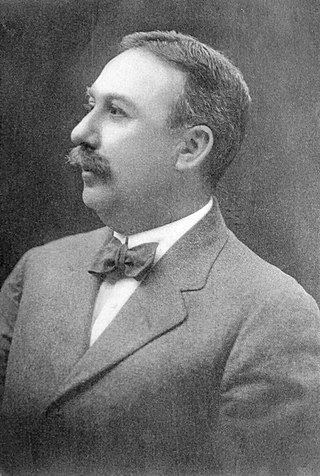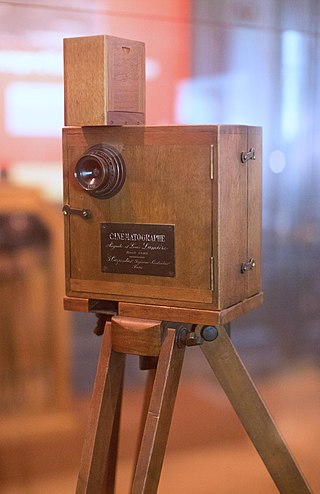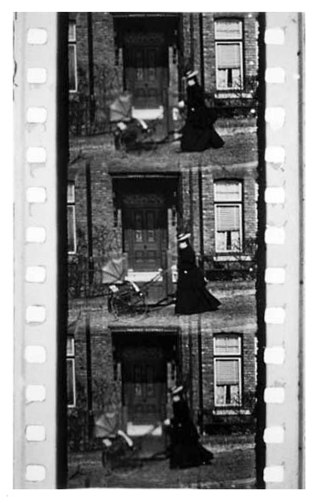Related Research Articles

The Lumière brothers, Auguste Marie Louis Nicolas Lumière and Louis Jean Lumière, were French manufacturers of photography equipment, best known for their Cinématographe motion picture system and the short films they produced between 1895 and 1905, which places them among the earliest filmmakers.
The history of film chronicles the development of a visual art form created using film technologies that began in the late 19th century.

Cinematography is the art of motion picture photography.
The following is an overview of the events of 1895 in film, including a list of films released and notable births.
The following is an overview of the events of 1896 in film, including a list of films released and notable births.
The following is an overview of the events of 1897 in film, including a list of films released and notable births.

The Kinetoscope is an early motion picture exhibition device, designed for films to be viewed by one person at a time through a peephole viewer window. The Kinetoscope was not a movie projector, but it introduced the basic approach that would become the standard for all cinematic projection before the advent of video: it created the illusion of movement by conveying a strip of perforated film bearing sequential images over a light source with a high-speed shutter. First described in conceptual terms by U.S. inventor Thomas Edison in 1888, it was largely developed by his employee William Kennedy Laurie Dickson between 1889 and 1892. Dickson and his team at the Edison lab in New Jersey also devised the Kinetograph, an innovative motion picture camera with rapid intermittent, or stop-and-go, film movement, to photograph movies for in-house experiments and, eventually, commercial Kinetoscope presentations.

Edwin Stanton Porter was an American film pioneer, most famous as a producer, director, studio manager and cinematographer with the Edison Manufacturing Company and the Famous Players Film Company. Of over 250 films created by Porter, his most important include: What Happened on Twenty-third Street, New York City (1901); Jack and the Beanstalk (1902); Life of an American Fireman (1903); The Great Train Robbery (1903); The European Rest Cure (1904); The Kleptomaniac (1905); Life of a Cowboy (1906); Rescued from an Eagle's Nest (1908); and The Prisoner of Zenda (1913).

Birt Acres was an American and British photographer and film pioneer. Among his contributions to the early film industry are the first working 35 mm camera in Britain (Wales), and Birtac, the first daylight loading home movie camera and projector. He also directed a number of early silent films.

Actuality film is a non-fiction film genre that, like documentary film, uses footage of real events, places, and things. Unlike documentaries, actuality films are not structured into a larger narrative or coherent whole. In practice, actuality films preceded the emergence of the documentary. During the era of early cinema, actualities—usually lasting no more than a minute or two and usually assembled together into a program by an exhibitor—were just as popular and prominent as their fictional counterparts. The line between "fact" and "fiction" was not as sharply drawn in early cinema as it would be after documentaries came to serve as the predominant non-fiction filmmaking form. Actuality is a film genre that remains related to still photography.

Robert William Paul was an English pioneer of film and scientific instrument maker.

Max Skladanowsky was a German inventor and early filmmaker. Along with his brother Emil, he invented the Bioscop, an early movie projector the Skladanowsky brothers used to display a moving picture show to a paying audience on 1 November 1895, shortly before the public debut of the Lumière Brothers' Cinématographe in Paris on 28 December 1895.
The decade of the 1890s in film involved some significant events.

L'Arroseur Arrosé is an 1895 French short black-and-white silent comedy film directed and produced by Louis Lumière and starring François Clerc and Benoît Duval. It was first screened on June 10, 1895.

A film – also called a movie, motion picture, moving picture, picture, photoplay or (slang) flick – is a work of visual art that simulates experiences and otherwise communicates ideas, stories, perceptions, feelings, beauty, or atmosphere through the use of moving images. These images are generally accompanied by sound and, more rarely, other sensory stimulations. The word "cinema", short for cinematography, is often used to refer to filmmaking and the film industry, and the art form that is the result of it.

Marie-Georges-Jean Méliès was a French illusionist, actor, and film director. He led many technical and narrative developments in the early days of cinema.

A Sea Cave Near Lisbon is an 1896 British short silent actuality film, directed by Henry Short, featuring a view looking out to sea through the Boca do Inferno cave near Lisbon, with waves breaking in. The film was popular with audiences and received positive reviews.

The history of film technology traces the development of techniques for the recording, construction and presentation of motion pictures. When the film medium came about in the 19th century, there already was a centuries old tradition of screening moving images through shadow play and the magic lantern that were very popular with audiences in many parts of the world. Especially the magic lantern influenced much of the projection technology, exhibition practices and cultural implementation of film. Between 1825 and 1840, the relevant technologies of stroboscopic animation, photography and stereoscopy were introduced. For much of the rest of the century, many engineers and inventors tried to combine all these new technologies and the much older technique of projection to create a complete illusion or a complete documentation of reality. Colour photography was usually included in these ambitions and the introduction of the phonograph in 1877 seemed to promise the addition of synchronized sound recordings. Between 1887 and 1894, the first successful short cinematographic presentations were established. The biggest popular breakthrough of the technology came in 1895 with the first projected movies that lasted longer than 10 seconds. During the first years after this breakthrough, most motion pictures lasted about 50 seconds, lacked synchronized sound and natural colour, and were mainly exhibited as novelty attractions. In the first decades of the 20th century, movies grew much longer and the medium quickly developed into one of the most important tools of communication and entertainment. The breakthrough of synchronized sound occurred at the end of the 1920s and that of full color motion picture film in the 1930s. By the start of the 21st century, physical film stock was being replaced with digital film technologies at both ends of the production chain by digital image sensors and projectors.

Incident at Clovelly Cottage, also known as Incident Outside Clovelly Cottage, Barnet, shot by Birt Acres and produced by Acres and his collaborator Robert W. Paul in March 1895, was the "first successful motion picture film made in Britain".
References
- ↑ Rossell, Deac (2 January 2017). "Rough Sea at Dover: a genealogy". Early Popular Visual Culture. 15 (1): 59–82. doi:10.1080/17460654.2016.1263577. ISSN 1746-0654. S2CID 164772763.
- ↑ Barnes, John (1996–1998). The beginnings of the cinema in England 1894-1901. Maltby, Richard, 1952-. Exeter [England]: University of Exeter Press. pp. 65–67. ISBN 0859895645. OCLC 36996858.
- ↑ "Rough Sea at Dover". Screenonline. Retrieved 9 April 2007.
- ↑ "Buy Early Cinema: Primitives and Pioneers (2-DVD set) - Early Cinema: Primitives and Pioneers". shop.bfi.org.uk. Archived from the original on 9 January 2015. Retrieved 19 March 2019.